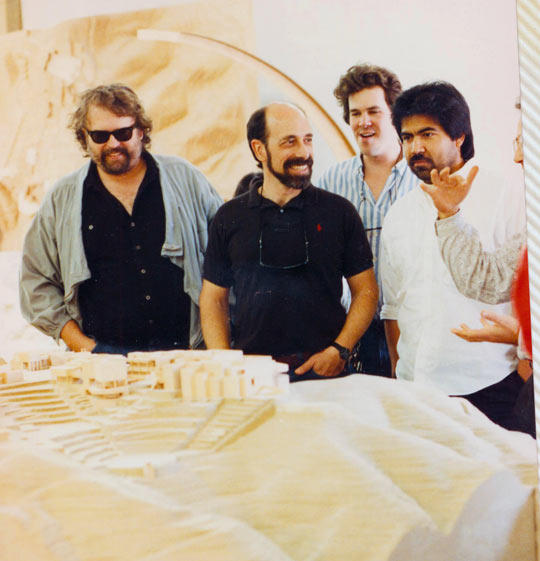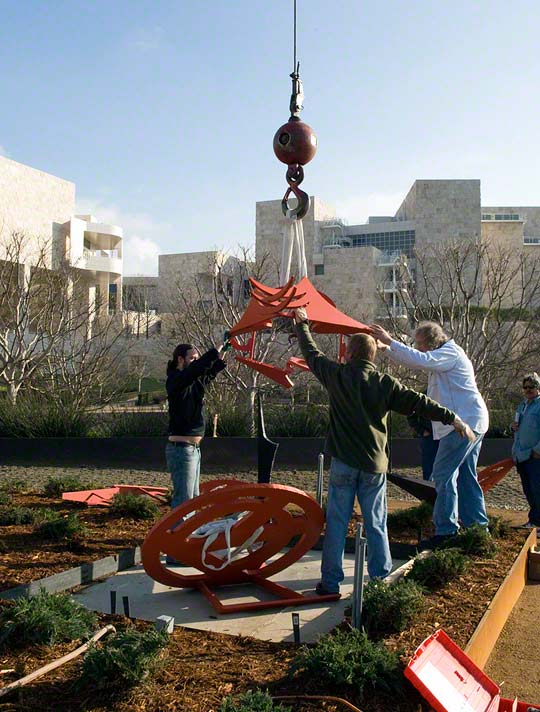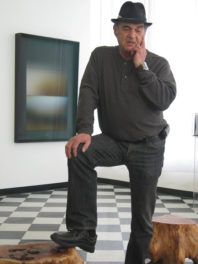On the occasion of head preparator Bruce Metro’s retirement today from the Getty Museum after 31 years, chief registrar Sally Hibbard and senior conservator for antiquities Jerry Podany, also longtime Getty employees, sat down to discuss Bruce’s impact on the Getty.

Bruce Metro (far left) with some of his staff looking at an early model for the Getty Center
Jerry Podany: Sally, what’s your earliest recollection of Bruce?
Sally Hibbard: That would be when he came for his job interview at the Getty in 1979. I asked him about his long-range career goals, as I was trying to determine whether he’d stay longer than a year or two. His reply was that he couldn’t think of another job that was a better match for him than the one at the Getty, considering his experience with and desire to work on art handling, installation, packing, and crating. After 31 years, I’d say the Getty got its money’s worth.
What’s your earliest recollection, Jerry?
Jerry Podany: Well, besides the period when he took to leaning out of his old VW van and yelling at me through a bullhorn as he passed me on PCH, I remember wondering how the new preparator would be different from the previous staff who filled the role. It was such a small community then and newcomers had great influence on the dynamic. While I had been with the museum only since mid-1978, it was clear from the start that Bruce brought a more organized and professional response to the job. And an edginess tinged with humor (lots of humor), and a large dose of cynicism. Fairly early on, he seemed willing to work more closely with conservation, particularly on expanding the kinds of materials and techniques being applied in Preparations. He certainly kept that going.
Jerry Podany: How would you summarize Bruce’s work at the Getty?
Sally Hibbard: A museum preparator prepares the collections for display, storage, and travel. Bruce did this with great skill, but he did so much more. He became a leader at the Getty in seismic mitigation, emergency planning, gallery lighting, and museum construction. He was knowledgeable about art handling when he arrived at the Getty, but he continuously researched new products used for displaying, storing, and shipping art and implemented their use at the Getty. What he didn’t know, he found out.

Bruce Metro at a meeting with Getty Center architects and other Getty Museum staff members
Sally Hibbard: Jerry, you’ve worked with Bruce on seismic mitigation over the years. Talk about your experience with him on that.
Jerry Podany: We were both lucky that John Walsh was willing to provide support for developing mitigation and took the threat of earthquakes seriously. And preparing a response to any kind of emergency was made a lot easier by Wilbur Faulk, who brought in his experience from the Fire Department. Bruce quickly took a leadership role in this area and brought to it his signature sense of practicality and insight. He took it seriously and often challenged the status quo. I remember once, during a yearly drill after we’d been told that in a real emergency any staff member had the option to leave the site if they decided they needed to, he questioned if that was actually what was meant. So in the middle of the drill, he and I decided to announce we were leaving. Bruce always enjoyed trumping the status quo, and I would say that was one of his best—but of course not his only.
Jerry Podany: What do you think was Bruce’s most significant contribution to the Getty?
Sally Hibbard: I’d say it was his work on the building of the new museum at the Getty Center. With his eye for detail, he checked all the continuously updated architectural plans to ensure that the art path (the route art objects would take to get to the galleries, storerooms, and conservation labs) was unimpeded and big enough for the largest works in the collection. He was also instrumental in the installation of louvers in the ceilings of the Getty Center’s top floor to allow daylight, but not too much daylight, into the galleries.
Because of his efforts, we have a dedicated art loading dock that works, ample freight elevators, and natural light for our paintings on display at the Getty Center.
What would you say, Jerry?
Jerry Podany: Of course everything you’ve said, but in many ways it has been Bruce’s consistency. He’s led an essential department through both ample and tough times with a constant demand for excellence in both performance and results. The job is enormously broad and demands can be significant, especially with expectations so high and deadlines so relentless. Somehow Bruce just kept pace and led his team through it.

Bruce Metro (at right) installing Gandydancer’s Dream by Mark di Suvero at the Getty Center
Jerry Podany: Sally, what will you miss most about Bruce?
Sally Hibbard: Besides his tremendous problem-solving abilities, I guess it will be his irreverence for Getty bureaucracy. Also his recommendations for fine tequila and good Thai restaurants. What will you miss?
Jerry Podany: He was irreverent? Really? (Laughs.) What will I miss…that’s easy…I’ll miss Bruce. It’s both that simple and that complex. At the Getty, his name has become synonymous with high standards, with both real and teasing cynicism (I am sure he will never believe this is an actual chat and probably think it’s a series of e-mails that are being refined back and forth, for example…). I’ll miss the challenges he could lay down in front of all of us when we were sure we’d worked out the correct answer, but hadn’t. And I’ll miss a friend who I’ve often turned to for help in working out practical solutions.
He brought a rare and complete set of talents to a complex field, where the usual response is to either overreact or contract out. A lot of the beauty we see in the galleries, both at the Center and at the Villa where it all began, can be credited to Bruce.




Comments on this post are now closed.